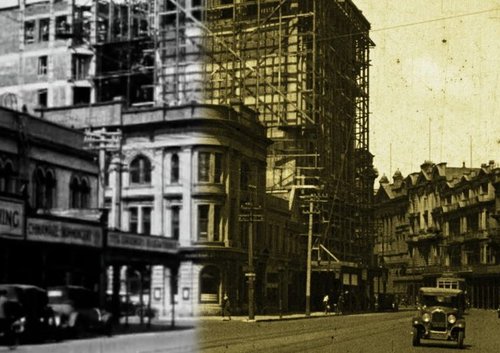
A new scan showing parts of New Zealand News and Views [10, 11, 12], in particular the construction of the Australian Temperance and General Mutual Life Assurance Society (T&G) Building.
On the Facebook post for this video, we received queries from viewers about why we had added a sepia tone to the footage. While there is a noticeable change between the old and the new scan, the sepia tone is actually original – nothing has been added.
Leslie Lewis, our Manager Film Preservation – Poutaki Rokiroki Kiriata, explains more:
‘Yes, this is the original tint – previous copies had been done from black and white prints as videos were made from the viewing copies we had made from the nitrate. Those viewing copies were black and white because we could not afford to copy the colour at the time. This is in fact what the original film looked like and is what audiences would have seen – in fact most film would have been tinted, rather than black and white, for a number of reasons, including being easier on the eyes.
After scanning the film, we graded and colour-corrected the scans to match the original, “projecting” a frame from the original nitrate and comparing it side-by-side with the digital preservation to make sure they match exactly.
“Projecting” is in quotes because we cannot project nitrate film in New Zealand’.
Part of our work as an archive is to show material in a state that is as close as possible to what audiences would have seen at the time. We’ll have an upcoming blog in which we take an in-depth look at how we apply archival standards to our film work.
Learn more about film tinting in our blog, The Colour of Silent Film.
Our friends at the National Film and Sound Archive of Australia covered many of these issues in their blog series Dying Light.
Hero image: Screengrab from New Zealand News and Views [10, 11, 12].